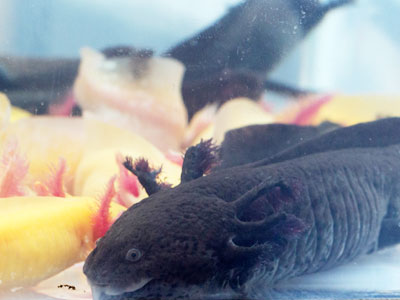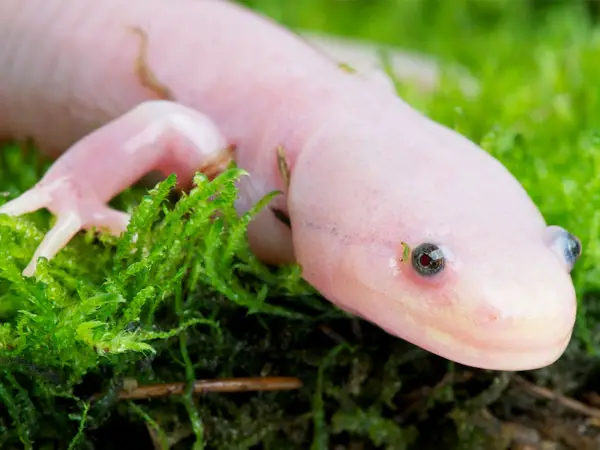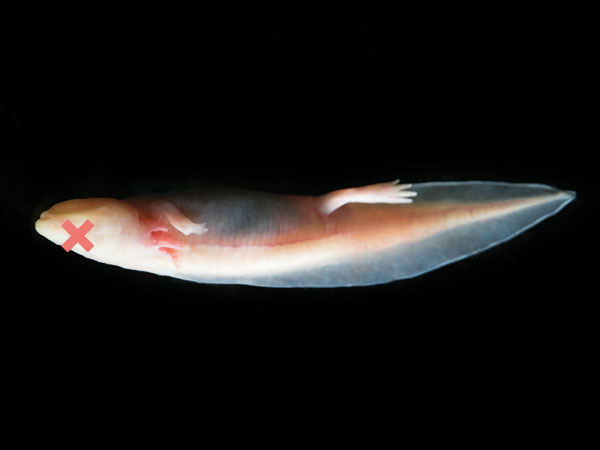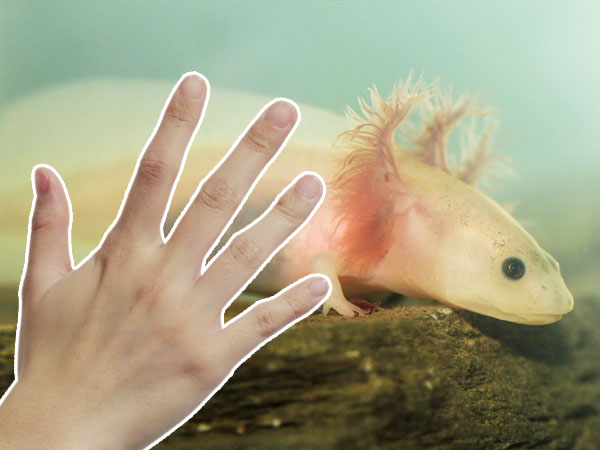
You may be familiar with a certain type of axolotl, the one with a white-pinkish body, and you may think all axolotls look like that, however, there are more types of axolotls, some of which are the result of crossbreeding.
Besides the color morphs that exist naturally and as a result of crossbreeding, there are a few uncommon morphs that only exist in laboratory settings.
In this article, I will focus on giving you an overview of the different types of axolotls or axolotl color morphs, so you can expand your knowledge of the different types of axolotls.
Common Axolotl Color Morphs
The color of an axolotl is determined by chromatophores, which is another name for pigment cells. Among these cells we can distinguish:
- melanophores, which are a black-brown pigment seen in the wild type axolotl
- xanthophores, which are a yellow-reddish pigment, and
- iridophores, which are responsible for the shiny iridescence we can observe on the skin of some axolotls.
Depending on the distribution and presence or absence of these pigment cells, we can observe the following types of axolotls:
Wild Type Axolotl
The wild type axolotl has purple to gray gills and its body is a combination of dark brown, black and shades of green with yellow or gold iridophore speckles. Eyes are dark with a yellow ring around the pupils. Wild type axolotls are common in home aquaria.
Leucistic (White) Axolotl
The white-pink axolotl that you may be very familiar with is the leucistic type. The dark eyes of this axolotl contrast well with its body. Their gills are a bright pink or red. Sometimes, the leucistic axolotl can develop grey/dark freckles on its head and back.
Many wrongly assume that the white axolotl is an albino axolotl. This is not the case since albino axolotls have white eyes as well, plus the leucistic axolotl has color cells on its head and back (hence the grey or dark speckles they can develop).
White Albino
The white albino is very similar in appearance to the leucistic axolotl, but their eyes are also pinkish instead of black. The white albino lacks dark color pigments but do have iridophores.
Golden Albino
Dark axolotls lacking the black pigments will have a yellowish-golden color. These golden albino axolotls have peachy colored gills, shiny patches on their bodies and clear eyes.
Melanoid
The melanoid axolotl is similar to the wild type axolotl, however, they have a higher count of dark pigments and lack the shiny pigments that create the yellow speckles that we can observe on the wild type axolotl. What results is a solid black colored axolotl.
The albino variety of the melanoid is somewhat similar to the golden albino, except it has a predominantly white body with only hints of yellow xanthophores on the head and back.
These are the most common axolotl varieties that you can find in home aquaria and they typically sell between $20-$70, depending on age and size.
But let’s also discuss some of the rarest axolotl types that you can only find in labs or as an interesting result of crossbreeding.
Unique Axolotl Morphs
These axolotl morphs are so rare that there are only a few specimens in the world. They’re difficult to obtain and they’re usually the result of crossbreeding that produced happy little “accident”.
Here are the rarest axolotl morphs:
Chimera Axolotl
This is an extremely rare variety that cannot be duplicated in breeding. In fact, there’s only a 0.00001% chance for an axolotl to be a chimera or even survive for that matter.
This axolotl has a split-on-the-middle appearance and looks like it’s half wild type, half leucistic.
Some argue that chimera axolotls are actually mosaic axolotls with a split color variation since the chances of two eggs fusing together and each part developing according to the side it came from is more like a stretch of the imagination than a reality.
Don’t hold your breath trying to breed chimera axolotls, it’s extremely rare. If you do find one online, expect the price to be steep. Some chimera axolotls can sell for as much as $2000.
Mosaic Axolotl
The mosaic axolotl is like the chimera in the sense that it shows the phenotype of two cells that formed during development, but they lack the split-down-the-middle color variation.
This axolotl variety is also difficult to reproduce through breeding since the fusion of the two cells is an accidental one. Plus, these axolotls are usually infertile.
Piebald Axolotl
The piebald axolotl may be a variation of the leucistic axolotl, but it has much more pronounced dark pigments on their heads and tops that go all the way down to the sides and tail.
The dark spots on the piebald axolotl are much darker and much more pronounced than in the case of leucistic axolotls. Luckily, this trait is inheritable, so piebald axolotl can produce other piebald axolotls.
Silver Dalmatian
Mostly available in the US, this is a purplish looking axolotl with dalmatian-like spots throughout its body. It’s rare and there are very few. They’re also known as purple axolotls or lavender axolotls.
Enigma
This is probably a one of a kind axolotl that comes from a US breeder. It has a dark green body with yellow-green speckles throughout its body. It’s a bit like a wild type but has much more pronounced yellow speckles.
Firefly
These axolotls are the result of embryonic graphing and they were produced by Lloyd Strohl II from USA in 2016. This axolotl type looks like either a mosaic axolotl with a light tail, or a leucistic axolotl with a dark tail. Firefly axolotls were bred as part of an experiment to examine the distribution and activation of melanocytes in leucistic and mosaic axolotls.
As for other lab-grown axolotls that have a peculiar color variation:
GFP Axolotl
These are glow in the dark axolotls that have been created by researchers by genetically modifying a protein in the DNA of the axolotls. This protein is called the Green Fluorescent Protein.
Because of the GFP, these axolotls have a vibrant green glow under UV lights. Researchers have genetically modified this type of axolotl to closely study the cells involved in axolotl regeneration.
The gene is simply passed onto offspring, so you may buy these online if you’re interested in having a glow in the dark axolotl.
Copper Axolotl
Copper axolotls are an albino variety, they lack melanophores. They have red-tinted eyes, lay white eggs, and their bodies are a light brown and pinkish color, speckled with brown spots. They’re commonly found in Australia, Germany and the US.
How to Breed Axolotls?
Axolotls can be bred in captivity with quite a lot of success. In fact, currently, the axolotls that are bred and raised in captivity may outnumber axolotls in the wild.
It’s best to breed axolotls after they’ve reached 18 months of age. This is especially important for female axolotls in the case of female axolotls because breeding can put a lot of strain on their bodies.
Another reason why it’s advisable to wait for axolotls to reach sexual maturity is to be able to correctly determine their genders.
Until they reach adulthood and develop their sexual organs it’s next to impossible to tell their sex. Once they reach sexual maturity, it can be observed that the male axolotl’s cloaca is larger and swollen, while the female sexual organ will only display a tiny bump, if any.
When breeding, axolotl have an interesting mating dance, the purpose of which is for the male axolotl to deposit spermatophores and the female to take these up in her cloaca to fertilize her eggs. During spawning, the female axolotl can release hundreds of eggs.
To ensure the survival of the eggs, both adult axolotls must be removed from the breeding tank to allow the eggs to hatch.
Under the right tank conditions and water temperature, the eggs will hatch in a couple of weeks. Baby axolotls don’t take on food right away, they feed on their yolk sac, but within 72 hours they’re ready to eat live foods such as baby brine shrimp, daphnia or microworms.
Most axolotl owners report successfully breeding axolotls from December to June, which is the breeding season for axolotls in the wild.
Keeping axolotls in a room that is exposed to natural daylight and seasonal temperature changes can help with breeding.
Conclusion
As you can see, there are several axolotl varieties. The most common ones you can easily buy from breeders, the other varieties are either only available in research labs or as a result of an accidental mutation during breeding.
The leucistic or white axolotl is the most widespread in home aquaria, although it’s closely followed by the wild type axolotl.
Rare axolotl morphs can be very expensive since they’re so rare, but common axolotls can be acquired at a reasonable price.
I hope this article on the different types of axolotls has served as a good introduction to axolotl color morphs and you now know that the white axolotl is not the only type of axolotl you can get.




